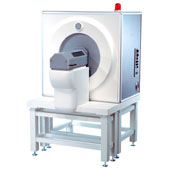Computed Tomography: Difference between revisions
From Embryology
No edit summary |
No edit summary |
||
| Line 1: | Line 1: | ||
==Introduction== | ==Introduction== | ||
[[File:Micro-computed tomography apparatus.jpg|thumb|Micro-computed tomography apparatus]] | |||
Computed Tomography or computed axial tomography (CAT or CT scan) began in 1970's using x-ray and a computer to produce images either as individual slices or reconstructed to give three dimensional (3D) views of specific anatomical regions or structures.This page currently has links to x-ray micro-CT movies of early mouse development. (More? Mouse Development). | Computed Tomography or computed axial tomography (CAT or CT scan) began in 1970's using x-ray and a computer to produce images either as individual slices or reconstructed to give three dimensional (3D) views of specific anatomical regions or structures.This page currently has links to x-ray micro-CT movies of early mouse development. (More? Mouse Development). | ||
Revision as of 08:51, 9 April 2010
Introduction
Computed Tomography or computed axial tomography (CAT or CT scan) began in 1970's using x-ray and a computer to produce images either as individual slices or reconstructed to give three dimensional (3D) views of specific anatomical regions or structures.This page currently has links to x-ray micro-CT movies of early mouse development. (More? Mouse Development).
Other potential developmental research imaging techniques include: positron emission tomography (PET), single photon emission computed tomography, magnetic resonance imaging, computed tomography, optical bioluminescence, fluorescence and high frequency ultrasound.
Some Recent Findings
- Rapid Three-Dimensional Phenotyping of Cardiovascular Development in Mouse Embryos by Micro-CT with Iodine Staining. Degenhardt K, Wright AC, Horng D, Padmanabhan A, Epstein JA. Circ Cardiovasc Imaging. 2010 Feb 27. PMID: 20190279
- Johnson JT, Hansen MS, Wu I, Healy LJ, Johnson CR, Jones GM, Capecchi MR, Keller C. Virtual histology of transgenic mouse embryos for high-throughput phenotyping. PLoS Genet. 2006 Apr;2(4):e61. PMID: 16683035 | PLoS
